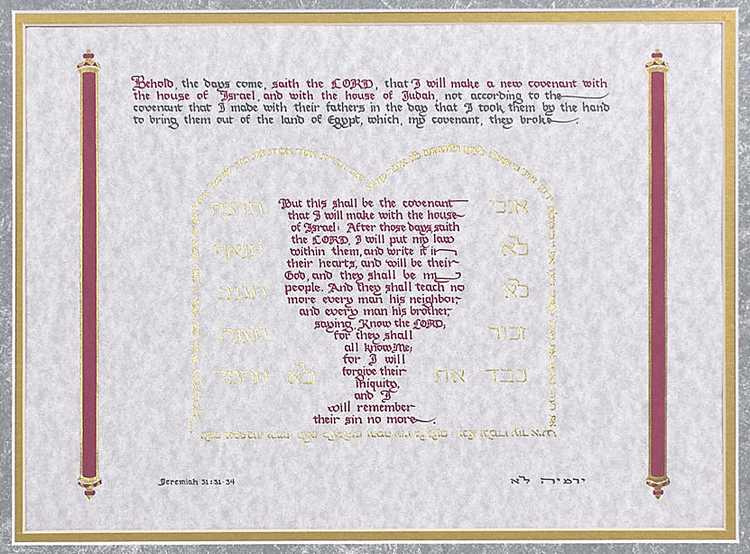
The Study of Last Things
by WordExplain
Bringing Truths from Different Books of the Bible into Focus, Perspective, and Understanding.
 |
Eschatology The Study of Last Things by WordExplain Bringing Truths from Different Books of the Bible into Focus, Perspective, and Understanding. |
"Behold, days are coming," declares the LORD, "when I will make a new covenant with the house of Israel and with the house of Judah," Jeremiah 31:31 |
                   |
The New Covenant  New Covenant. The new
initiative of God whereby He
formally commited to writing His laws on the hearts of certain people,
enabling
them to know Him and be His people and enabling Him to be their God (Jer. 31:31-34). The
achievement of the
New Covenant. The New
Covenant was designed actually to accomplish spirituality, whereas the
former
covenant (Ex. 19:5; 24:6-8;
Deut. 5:2), known
variously as the Law, the
Mosaic Law, the Torah, or the “Old Covenant,” was not so designed (Jer. 31:32; Rom.
3:19-20; 5:20; 7:7;
Gal. 2:16; 3:19; 6:16).
The Old Covenant was designed to demonstrate that people are sinners,
that they
could not, in fact, keep the Law, no matter how hard they tried (Acts 15:10; Rom.
7:7-11; 14-24). The New
Covenant was designed to
replace stony hearts that could not
obey God with hearts of flesh that do
obey Him (Ezek. 11:19; 36:26). The Old
Covenant was a conditional, performance-based
covenant
promising blessing if the people
obeyed (Deut.
28),
whereas the
New Covenant is an unconditional, grace-based
covenant
promising fellowship with God because He provides the beneficiaries
with
responsive hearts that do obey, and
because He mercifully forgives their sins (Jer. 31:31-34). The beneficiaries of the New Covenant. Clearly, the New Covenant was promised to Israel. Through the prophet Jeremiah, Yahweh clearly stated the following: 31“Behold, days are coming,” declares the LORD, “when I will make a new covenant with the house of Israel and with the house of Judah” (Jer. 31:31). Not only would Yahweh make this New Covenant with Israel, but He would make it with the entire nation of Israel, both the Northern and Southern kingdoms. But the New Covenant is so sweeping in scope that God had purposed to include not only Jewish people, but also Gentiles as beneficiaries. Jesus announced to His followers that the cup represented the new covenant in His blood (Luke 22:20). The Apostle Paul, writing to the largely Gentile Church of Corinth, laid down guidelines for the observance of the Lord’s table based on the self-same statement of Jesus (1 Cor. 11:25; see 1 Cor. 11:23-34). Paul, apostle to the Gentiles (Rom. 1:5; 11:13; Gal. 2:8; 1 Tim. 2:7), himself claimed to be a minister of the New Covenant (2 Cor. 3:6). Doubtless, the writer to the Hebrews understood that Christians in the Church Age were beneficiaries of the New Covenant (Heb. 8:6-13; 9:11-15; 12:22-24), regardless if they were Jewish or Gentile. Indeed, it has long been God’s plan to grant “born in Zion” status to believing Gentiles (Psalm 87:1-7; see the author’s Analysis of Psalm 87). The inauguration of the New
Covenant. The New Covenant was inaugurated by the
sacrificial death and resurrection of Jesus Christ (Luke
22:20; Heb. 9:15; 12:24).
The one who places His faith in Jesus Christ is born into the family of
God by the power of the Holy Spirit, and is given a new nature through
which He can effectively serve God (John
1:12-13; 3:16-18). As He yields his own being to the control
of the Holy Spirit (Eph.
5:18), he more and more exhibits the fruit of the Holy Spirit
(Gal.
5:22-23).
Complete sanctification and access of the benefits of the New Covenant
comes after the believer in Jesus possesses a glorified, resurrected
body, no longer able to sin or afflicted with the various curses of sin
(Rev.
21:1-22:5). The time-frames for beneficiaries of the New Covenant. The members of the Church, including both Jew and Gentile, are today in the Church Age beneficiaries of the New Covenant through faith in Jesus, the mediator of the New Covenant (Heb. 8:6; 9:14; 12:24). Redeemed national Israel will benefit from the New Covenant in a remarkable way during Christ’s one-thousand-year reign upon earth (Isaiah 59:20-60:22; Zech. 12:10-13:1; 14:8-9; 20-21; Ezek. 40-48). Redeemed Israel and the Church, the Bride of Christ, both benefit remarkably throughout eternity in that both are inhabitants of New Jerusalem. The name of the city itself proclaims that God’s beneficent plan for redeemed Israel under the New Covenant is eternal. The identification of New Jerusalem as the bride of the Lamb (Rev. 21:2, 9) is grounds for stating that the Church is an eternal beneficiary of the New Covenant. Not surprisingly, the twelve gates of the city are inscribed with the names of the twelve tribes of the sons of Israel (Rev. 21:12) and the twelve foundation stones are inscribed with the names of the twelve apostles of the Lamb (Rev. 21:14). The apostles represent both Israel (Matt. 19:28) and the Church.
Eschatology
Index Page
WordExplain
by James T. Bartsch
(Scripture quotations taken from the NASB. Used by Permission.) Published November 9, 2010 Updated August 30, 2015 Button Bar Credit |